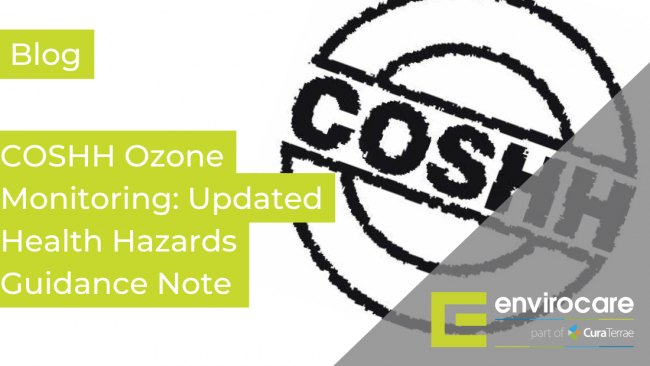COSHH Ozone Monitoring | Updated Health Hazards Guidance Note
4 April 2014

An updated Guidance Note has been released by the HSE regarding Ozone which outlines the potential health hazards and available control measures.
It draws attention to the potential ill health which exposure to Ozone can cause and indicates potential sources of Ozone at work as well as offering advice on the precautions you may need to take to Prevent Or Control Exposure and is primarily aimed at employers and managers of people exposed to Ozone in the course of their work.
The full HSE EH38 -Ozone | Health Hazards and Control Measures Guidance Note can be found here.
What Is Ozone?
Ozone (O3) is a form of oxygen. It is a colourless gas with a distinctive odour and is a normal constituent of the earth’s atmosphere. It is produced naturally from oxygen whenever enough ultraviolet (UV) radiation or electrical discharges occur, for example at high altitudes or by the action of lightning. Such natural occurrences are unlikely to produce hazardous concentrations at ground level. The majority of Ozone found near ground level is formed by photochemical reactions involving oxides of nitrogen and hydrocarbons.
In a workplace Ozone is potentially generated by UV printing process where UV is used to cure (dry) the inks, and in welding activities.
The Dangers of Ozone
Ozone is an unstable substance, but its rate of decomposition varies widely depending on temperature and humidity. A given Ozone output which yields a faint trace of Ozone in a workroom atmosphere on a humid day may create an undesirable concentration on a dry day. These factors are important when considering occupational exposure to Ozone.
Ozone is a powerful oxidising agent and can react explosively with oil and grease. Low concentrations of ozone have a significant effect upon textiles, fabrics, organic dyes, metals, plastics and paints and cause the characteristic cracking of stressed rubber, commonly called ‘weathering’.
Complying With COSHH Regulations
The current Workplace Exposure Limits (WEL) for Ozone is 0.2 ppm in air averaged over a 15-minute reference period. If exposure to Ozone cannot be prevented then the principles of good control practice need to be applied to ensure that the workplace exposure limit is not exceeded.
Under COSHH regulation 6, employers must not carry out any work which is liable to expose any employees to any substance hazardous to health. This is unless they have made suitable and sufficient assessment of the risks created by that work to the health of those employees and of the steps that need to be taken to meet the requirements of COSHH. You will need to carry out a ‘suitable and sufficient’ risk assessment wherever exposure to ozone is likely to occur. An action plan/checklist for assessment would involve:
- Where is Ozone likely to be generated?
- Is exposure likely?
- Who is likely to be exposed?
- Can the exposure be prevented?
- If the exposure cannot be prevented, estimate the potential level of exposures
- If exposures exceed or are likely to exceed the WEL, decide what control measures are needed and take appropriate action.
Preventing and Controlling Exposure To Ozone
COSHH requires that precautions should be taken for the protection of every employee who may be exposed to hazardous substances.
Prevention of exposure to Ozone should be the preferred approach. Adequate control should be achieved, as far as reasonably practicable, by the use of process or engineering controls. Where these measures are not adequate, you should consider further controls, such as improved systems of work and the use of respiratory protective equipment. Whatever controls are chosen, there is a need to check that they are effective and remain effective.
Experts In COSHH Ozone Monitoring and Consulting
Envirocare is a leading Occupational Hygiene and Health and Safety services provider with over 20 years of experience throughout the UK. We offer comprehensive COSHH Ozone monitoring and COSHH Risk Assessment advice to ensure compliance with the relevant exposure limits.
Envirocare will aid your COSHH risk assessment by carrying out COSHH Ozone monitoring to determine the levels of substances in the workplace and ensure the WEL value is not exceeded. We will also provide a detailed report on work practices and findings together with recommendations for remedial action.
Call us on 01274 738668 or fill out our Envirocare Enquiry Form for any queries regarding COSHH Ozone monitoring, Ozone consulting, workplace air sampling and COSHH surveys.
You can also read our Workplace Air Monitoring Service page for more information on our range of COSHH services.
